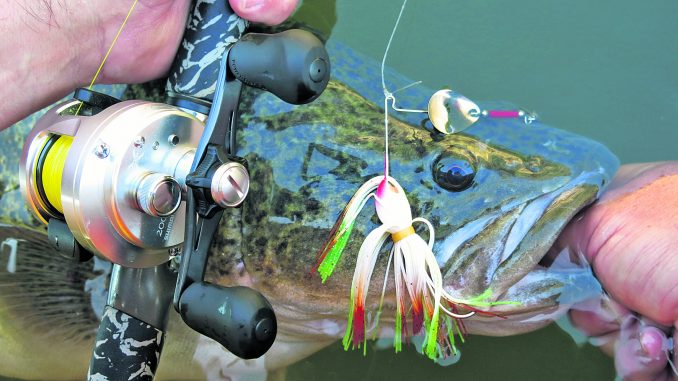
by Steve ‘Starlo’ Starling •
Mastering modern overhead reels isn’t so difficult, if you follow a few basic steps.
Last century, when I was much younger, casting overhead reels was a challenge and proficiency with baitcasters and overheads was seen as a badge of honour: something most of us keener anglers ultimately aspired to try.
Modern baitcasters are much easier to tame than their predecessors. However, while reduced, the risk of muffed casts remains. That’s because an overhead’s spool must spin (at considerable speed) during every cast. Problems arise when a significant difference occurs between the rate of that spool rotation and the progress of the lure or sinker through the air and into the water.
The most commonly encountered problem in this regard takes the form of loose loops of line rising suddenly from the rapidly spinning spool as the passage of the casting weight slows. That’s called an over-run. In more extreme cases, these loops can tangle together, catch back on themselves and suddenly snarl into something known as a backlash (a phenomenon that also goes by several much less polite names!) Particularly bad backlashes can result in broken or damaged lines, not to mention ugly tangles that take time to carefully tease undone.
In days of old, the only reliable safeguard against the dreaded backlash was something widely known as an ‘educated thumb’. The very same thumb that pinned and held the spool after the reel’s gears were disengaged, and then released it at the optimum moment in the casting stroke to send the lure flying on its way, would also hover gently over the whirring line load as it spun. That educated thumb felt for the first tell-tale brush of a rising loop, gently feathering the spool as the flight of the weight slowed, before clamping down to stop it completely as the sinker or lure hit the water.
Over the years, baitcaster and overhead reel manufacturers have tried all manner of built-in braking devices to tame that wildly spinning demon. These have included mechanical, magnetic, centrifugal, friction and even digital controls. All these clever systems work to varying extents, although none have completely removed the need for a little ‘smart thumb’ input from the nut that holds the rod.
If you’re a new chum to casting with overheads, I strongly suggest hitting the park or beach and having a few practice sessions before your first serious fishing foray. It might also pay not to spool up with the most expensive line on the market to begin with!
Make sure your sinker, lure or practice plug is heavy enough for easy casting, and that it falls into the suggested weight range of the rod (usually printed on the blank). As a rule of thumb, weights below 7g (1/4oz) are much harder to throw with an overhead reel, as are highly wind-resistant lures or complex rigs that tumble in flight.
Begin by winding the weight up to rod tip before free-spooling the reel and allowing the weight to simply drop to the ground. Practise stopping the spool with your thumb as the lure or sinker hits the dirt. After doing this exercise a few times, tighten the bearing cap on the handle side of the reel until it’s just firm enough to stop the weight from descending. Free spool the reel and gently back the bearing cap off until the weight slowly begins to drop. As it falls, ease the bearing cap pressure up again until it stops. Play around with this setting until you develop a feel for that precise point of release (where the weight begins to slowly descend). Leave it set there for now.
Next, move your attention to the opposite end of the reel, where there’ll be some sort of built-in cast control. If this mechanism has an external dial, crank the setting up to its maximum point, or just short of it (nine or ten on many reels). On some baitcasters, you’ll need to open the end plate using a quick release mechanism and manually engage a series of sliding brake blocks or magnets. Refer to the reel’s manual or on-line videos for information on how to do this, but start out by engaging all of these spool brakes to their maximum settings before closing the end plate.
You can now begin making gentle, smooth casts to get a feel for the reel. It should be quite difficult to suffer over-runs or backlashes using the maximum settings I’ve described, but they’ll also limit your casting distance. You’re effectively riding a bike fitted with training wheels! As you begin to feel more comfortable, you can slowly back off the mechanical cast controls described to free the spool up and increase your casting distance. Take it easy and be ready to re-apply controls if you change casting weights or face a headwind.
Baitcasters and overheads are wonderful tools for many applications, but unless you follow the steps described here when you start out, the problems described can turn the process into a nightmare… Happy casting!






